Hostile Waters: Antaeus Rising Preview
This 3D RTS has been in development for years. How's it shaping up?
One of the benefits of being a developer in the gaming industry is that if a product doesn't meet widespread success or doesn't fall in line with a team's initial plans, it's always possible to go back to the planning stages to find out what went wrong and then improve upon future releases. It seems as though British developer Rage Software took such an opportunity with Incoming--an arcadelike shooter in which you control different vehicles--by dissecting it and finding the game's weaknesses, what worked, and what could be added to make a better game. Hostile Waters: Antaeus Rising is obviously the result of that work, and while Incoming has its shortcomings, Hostile Waters improves upon its predecessor with a stronger story, deeper gameplay, and more detailed visuals.
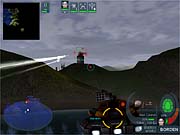
The year is 2032, and the world is finally at peace, but not everyone is pleased with the current state of affairs. A group composed of old-world leaders--those who benefit most from war and are located in a group of islands--hoard its remaining resources to launch an attack and break the peace, thus throwing the world back into a state of war. The only way the new world can fight back against this organization, called the Old World Cabal, is to resurrect a relic of the old world--an ancient machine equipped with a nanofactory capable of producing weapons and vehicles from a few scraps of metal. Your main objective is to infiltrate the islands that are inhabited by the Old World Cabal and to systematically destroy each island that leads up to the group's headquarters. Of course, such a task is much easier said than done, especially since some of the later missions require a significant amount of planning and strategy to successfully complete objectives.
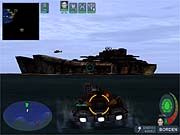
The new world has been forced to not only raise the Antaeus from its resting place at the bottom of the ocean, but to also call upon soldiers that have been dead for a number of years. During the last real war, soldiers were implanted with a device called the soulcatcher chips. The primary function of these chips was to essentially store the individual characteristics and personalities of the solider so that they could be used at a later time to control military vehicles on their own. The new world uses these soulcatcher chips in the vehicles built by the Antaeus, but you must choose wisely, because there are only 10 soulcatcher chips available at a time--the rest of your vehicles must be controlled manually, which can be rather difficult to deal with in the heat of battle. Your soulcatcher chip pilots continuously talk during battle, and this gives you vital information, such as the people who need assistance and the location of enemy weapons and units.
Hostile Waters: Antaeus Rising's story progresses as you travel through the 21 islands controlled by the Old World Cabal, but there are a number of different subplots that stem from the soulcatcher pilots. For example, you get to know each of the pilots through a series of real-time cinemas that show how the pilots met their demise, what their specialty was, and what kind of personality they had. In addition, during battle, the soldiers have conversations that reveal new information about the story or, more specifically, the Old World Cabal.
Your Arsenal
As in a typical strategy game, the core of Hostile Waters' gameplay focuses on the use of individual units, each with their own unique abilities and weaknesses. Before you go charging into battle, you need to become familiar with your units to plan an effective attack on the enemy. The ground-based vehicle with the most balanced abilities appears to be either the salamander or the shark, both of which are hovercrafts. Not only are they fast, but they also have a decent amount of firepower. If it appears that the salamander doesn't have enough power to get the job done, you also have access to the sentinel, a stationary gun that has a ridiculous amount of power. Of course, the sentinel's major drawback is that it can't move by itself, so you need to dedicate an entire unit to hoisting the sentinel into the air and bringing into the vicinity of the battle. The most powerful and useful vehicle is appropriately named the Behemoth, which has a massive arsenal and plenty of room for adding armor or other items. The Behemoth's only weakness is that it isn't quite as maneuverable as the salamander, but it really doesn't need to be since it can absorb a significant amount of damage. For those who prefer more of an aerial attack, the Antaeus can manufacture a number of aerial crafts, like helicopters, which are incredibly useful for scouting new areas and taking out remote targets.
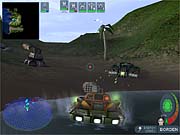
To build your vehicles, the Antaeus needs a steady supply of scrap metal for its nanofactory, which is responsible for building all the units you see. So, in addition to the typical military units, you also need to build a resource gatherer that can go into the battlefield and retrieve debris, whether it came from fallen structures, other units, or some other random object in the landscape. Running out of debris is a common occurrence if you go into battle with the sole purpose of taking out enemy targets and you decide not to build--or at least forget to build scavenger units.
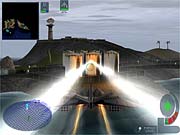
There are a number of other factors that affect your strategy before you even hit the battlefield. As previously noted, each unit has a different set of abilities that make it better than other unitsin specific situations. In some cases, the most basic advantage some units have over others is the ability to take on secondary attributes that come in the form of slots on the unit construction screen. For example, the salamander is the low-end hovercraft; therefore, it carries only a few extra slots that you can devote to additional armor, shields, or weaponry. Obviously, since it's such a relatively weak vehicle defensively, you want to add more armor or shields, but you're obviously limited by how much you can add, depending on how many slots are available. On the other side of the spectrum is the Behemoth, which has quite a few more slots than the low-end salamander, so there's more room to add shields, armor, or even secondary and tertiary weapons like the electromagnetic pulse. Choosing weapons to fit your mission is crucial to success in the initial phases of battle, but you'll find that your strategy can quickly break down, which forces you to take direct control over your units.
A Little of Everything
Upon starting a battle, the first screen you are introduced to is the Antaeus' three-dimensional map, where you can see the Antaeus, your vehicles perched on the deck of the Antaeus, and the front line of the enemy defense. In this screen, you can click on any unit and give them different orders that range from attack, attack and fallback, or set waypoints. The benefit to giving orders in this screen as opposed to doing it in the actual game is that everything is frozen, so you don't have to worry about any errant errors like telling a helicopter or a tank to go in the wrong direction. Moreover, you can order your aerial transports to pick up the ground-based units and set a landing point on the outskirts of the enemy defense. Of course, there are also negative impacts to giving orders on the map screen, one of them being that you can't really see how extensive the enemy's defense is, so it's hard to tell if you're sending a few of your units to an immediate death.
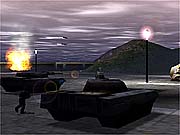
When you're done deciding where units are sent, it's time to move into the actual battle phase of the game. Here, Hostile Waters transitions to a camera (located on the Antaeus), which shows your vehicles taking off from the deck and performing their assigned tasks. While the camera isn't particularly useful, it's quite a sight to see your units take off and move toward the island. Switching to a specific angle, like the camera following a salamander hovercraft, is incredibly easy and is actually quite similar to first-person shooters Each unit is assigned a number that you can toggle with a quick press of the corresponding key. There is even a picture-in-picture view-- where you can see other units in a small window through the default third-person perspective--which can help you decide if you need to keep a closer watch on a particular unit. If it a unit seems to be in trouble, you can take direct control of the unit.
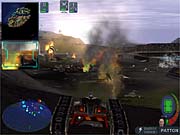
Taking direct control over a unit doesn't mean that you're merely relegated to giving it orders, but you actually become the pilot--all of a sudden, the similarities between Incoming and Hostile Water become rather apparent. There are a number of situations that require you to take direct control of the unit, but most of them usually involve precise attacks that otherwise couldn't be performed by a unit outfitted with a soulcatcher chip. For example, one mission requires that an aerial craft, like the helicopter, work with a hovercraft to take out a number of antiaircraft weapons surrounding a base. First, you must take direct control of the helicopter to scout out the base and determine where the antiaircraft guns are located. Once you've spotted them, you can order your hovercraft to approach the coastline while you're still in control of the helicopter--since you need to defend yourself against other helicopters and other possible unseen antiaircraft weapons. When the hovercraft arrives, you can take direct control of it, take out the antiaircraft weapons and do any additional damage, and then retake direct control of your helicopter and finish off the target. There are a number of ways to deal with the same situation--the course of action to take is completely up to you.
Final Thoughts
In addition to the basic strategy of using units according to their abilities, a few other factors can influence the outcome of a battle. The soulcatcher cards are important because the formerly human pilots specialize in piloting specific units. If you put a soulcatcher helicopter pilot in a tank, the pilot is going to express his dissatisfaction with your decision; plus, his performance on the battlefield won't be as effective. The environment and surrounding objects can have an effect on your strategy as well. For example, instead of directly taking out enemy targets, you can actually look for secondary objects such as oil derricks, electric towers, or radar dishes to inflict more damage with less risk to your own units. By destroying electric towers, you remove the enemy's power supply; therefore, you take away its ability to manufacture additional units. Obviously, destroying radar incapacitates the enemy's tracking systems, which makes it more difficult for enemy units to track where you are or how close your other units are to the enemy base. Weather also plays a role in Hostile Waters, because rain can make the terrain muddy and difficult for tanks to travel through; plus, other features, like fog, can make it difficult to see other units.
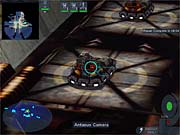
Visually, Hostile Waters: Antaeus Rising bares a strong resemblance to Incoming. The individual units, such as the helicopter and the tanks, are built in a similar futuristic style as the various craft found in Incoming. Also, different lighting effects from weapons and explosions are also quite similar, and even the way structures collapse looks familiar. However, representatives from Rage Software were quick to point out that it's a new engine that has a few advantages over Incoming's engine. One of them is the aforementioned weather effect, which, apparently, the new engine handles really well. Instead of just floating around in the air, the fog actually moves through the valleys and hills of the landscape, much like it would in real life. Another new visual feature is deformable terrain. Basically, if any of your major weapons miss a target and happen to hit a hillside or a mountain, a huge gash appears, instead of just a regular smokelike texture to indicate an explosion. The deformable terrain looks limited in the amount of damage it can incur, so it probably doesn't impact gameplay as much as it should. There are also some small details that are actually quite impressive, like small human soldiers that scatter throughout the base once you break through enemy defenses. And if you're so inclined, you can actually pin down enemy soldiers and shoot them by using one of your units.
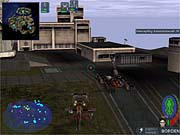
Hostile Waters: Antaeus Rising brings an interesting twist to the strategy genre by adding a strong action element in which you can take control of your units, much like you would in a military simulation--though Antaeus Rising is much more basic. It's only weakness at this point is the lack of a multiplayer mode. Unfortunately, Rage Software has yet to make a decision as to whether or not a multiplayer mode is in the works, since it wants to complete the single-player campaign before even touching a multiplayer mode. Otherwise, Hostile Waters: Antaeus Rising is a game that should appeal to an audience much wider than Incoming's.
Got a news tip or want to contact us directly? Email news@gamespot.com
Join the conversation